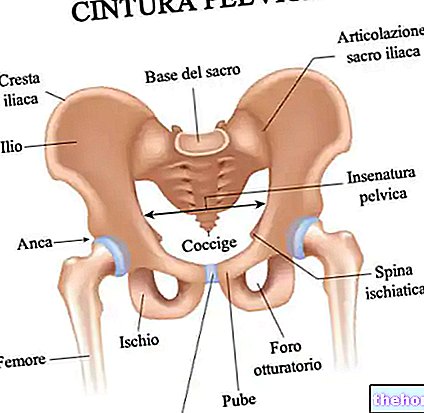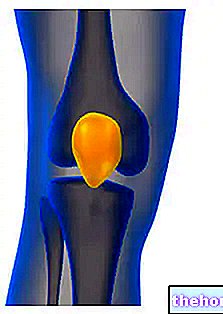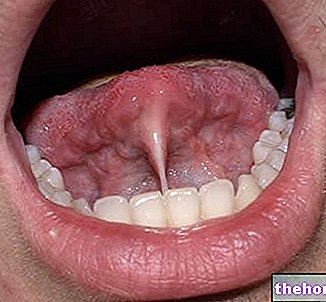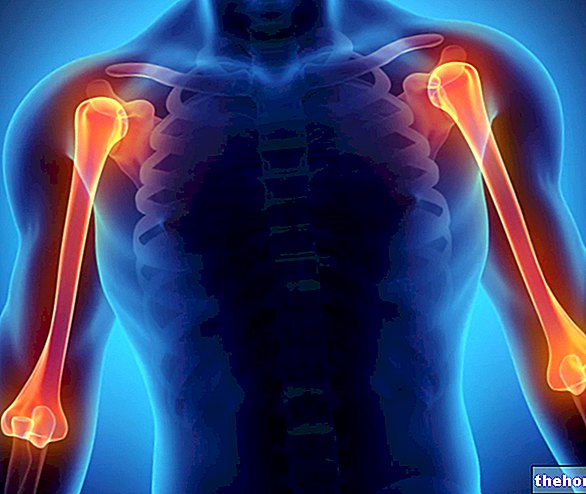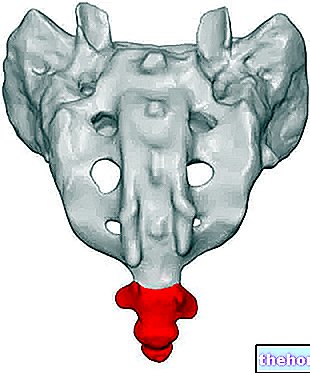Generality
A metatarsal, or metatarsal bone, is one of the 5 long bones, which, in each foot, are placed between the tarsal bones and the proximal phalanges of each toe.
In a generic metatarsus, three main portions can be distinguished, which are: the body, the base and the head.

In green, the metatarsal bones. Image from the site en.wikipedia.org
The body is the central bony portion, with a prismoid shape, which extends between the base and the head; the base is the proximal end, bordering and in articulation with a bone of the tarsus; the head, finally, is the distal end, connected and articulated with the proximal phalanx of a toe.
The traditional denomination of the 5 metatarsals requires the use of the first 5 Roman numerals. From this it follows that: the first metatarsal is the metatarsal bone that precedes the phalanges of the big toe, the second metatarsal is the metatarsal bone that precedes the phalanges of the first toe, the III metatarsal is the metatarsal bone placed before the phalanges of the third toe, the IV metatarsal is the metatarsal bone that precedes the phalanges of the fourth toe and, finally, the V metatarsal is the metatarsal bone which is placed anterior to the phalanges of the fifth toe.
The metatarsals are the seat of insertion of muscles and ligaments of the foot which are very important for the functionality of the latter.
Like any bone in the human skeleton, the metatarsals can also suffer fractures.
What is a metatarsal?
A metatarsal, or metatarsal bone, is one of the 5 long bones, which, in each foot, are positioned between the bones of the tarsus (or tarsal bones) and the proximal phalanges (or first phalanges) of each toe.
In a human foot, the metatarsals are 5 of the 26 total bones (7 tarsal bones, 5 metatarsal bones, and 14 phalanges).
Review of the meaning of the terms proximal and distal
Proximal and distal are two terms with the opposite meaning.
Proximal means "closer to the center of the body" or "closer to the point of" origin. Referring to the femur, for example, it indicates the portion of this bone closest to the trunk.
Distal, on the other hand, means "farther from the center of the body" or "farther from the point of origin". Referred (always to the femur), for example, indicates the portion of this bone farthest from the trunk (and closest to the knee joint).

Anatomy
In each metatarsus, three bony portions are distinguishable, called: body, base and head.
The body of a metatarsal it is its central bony portion, included between the so-called base and the so-called head. Prism-shaped in shape, it is slightly convex on the dorsal side and slightly concave on the palmar side; it tends to thin in the direction of the phalanges.
There base of a metatarsal it is its proximal extremity, preceding the body and clearly the head and bordering one or more tarsal bones. It has the shape of a wedge and, both on the palmar side and on the dorsal side, has a rough surface, which serves to anchor important ligaments of the foot.
Finally, the head of a metatarsal it is its distal end, following the body and the head and in close contact with the first phalanx of a specific finger (eg the head of the first metatarsal borders with the first phalanx of the big toe). Anteriorly, it has an oblong articular surface; sides, is flattened and has a small depression and a tubercle, on which other important ligaments of the foot are inserted; inferiorly (plantar surface), it has a typical groove.
By convention, the 5 metatarsals are indicated with the first 5 Roman numerals, namely I (first), II (second), III, IV and V. The metatarsal marked with the number I (I metatarsal) is the metatarsal bone that precedes the proximal phalanx of the big toe; the metatarsal indicated by the number II (II metatarsal) is the metatarsal bone preceding the proximal phalanx of the first toe; the metatarsal indicated by the number III (III metatarsal) is the metatarsal bone preceding the first phalanx of the second toe; the metatarsal identified with the number IV (IV metatarsal) is the metatarsal bone preceding the proximal phalanx of the fourth toe; finally, the metatarsal indicated by the number V (V metatarsal) is the metatarsal bone that precedes the first phalanx of the fifth toe.
Again by convection, the metatarsal considered more medial is the I metatarsus (that of the big toe), while the metatarsus considered more lateral is the V metatarsus (that of the fifth toe).
WITH WHICH TARSAL BONES DO METATARSUS BORDER?
The tarsus of the foot comprises 7 bones, which are: the talus, the calcaneus, the navicular, the cuboid, the lateral cuneiform, the intermediate cuneiform and the medial cuneiform.
Of these bony elements just mentioned, only the last 4 border with the metatarsals, namely: the cuboid bone, the lateral cuneiform, the intermediate cuneiform and the medial cuneiform.
The metatarsal-tarsal relationship is as follows:
- The first metatarsal borders on the medial cuneiform bone and only partially touches the intermediate cuneiform bone;
- The second metatarsal adheres mainly to the intermediate cuneiform bone and, secondarily, to the remaining cuneiform bones;
- The III metatarsal adheres to the lateral cuneiform bone;
- The IV and V metatarsus border the cuboid bone.
The particular arrangement of the three cuneiforms and the cuboid, with respect to the metatarsals, leads to the constitution of the so-called transverse arch of the foot.
ARTICULATIONS: SUMMARY AND NAME
Each metatarsal participates in 3-4 joints: a "joint with a tarsal bone, one or two joints with one or two adjacent metatarsals and, finally, a" joint with the first phalanx of a finger.
Going into more detail:
- The joints that join the metatarsals to the tarsal bones are called the tarsometatarsal joints. The tarsal-metatarsal joints feature the bases of the metatarsals and the tarsal bones bordering the latter, namely the three cuneiforms and the cuboid;
- The joints that join the metatarsals together are called the intermetatarsal joints. The extreme metatarsals, ie the I and V, take part in a single intermetatarsal joint, as adjacent to them there is only one metatarsal; on the contrary, the central metatarsals, that is the II, III and IV, are the protagonists of two intermetatarsal joints each, since adjacent to them there is a metatarsal on each side;
- The joints that connect the metatarsals to the phalanges of the toes are called metatarsophalangeal joints. The metatarsophalangeal joints stabilize the heads of the various metatarsals at the so-called bases of the first phalanges of the fingers.
LIGAMENTS
A ligament is a formation of fibrous connective tissue, which connects two bones or two parts of the same bone together.
The ligaments related to the metatarsals are:
- The tarsometatarsal ligaments, which run between the tarsal bones and the metatarsals and support the tarsometatarsal joints;
- The intermetatarsal ligaments, which originate and end only in the metatarsals and support the intermetatarsal joints. There are 3 subtypes of intermetatarsal ligaments: palmar, dorsal and interosseous;
- The metatarsophalangeal ligaments, which originate on the metatarsals and end on the phalanges of the toes and are responsible for strengthening the metatarsophalangeal joints.
MUSCLES
The terminal heads of some important muscles of the leg and the heads of origin of some important muscles of the foot are inserted on the metatarsals.
The muscles of the leg that end their path with the insertion on the metatarsals include:
- The anterior tibialis muscle. With its terminal head, s "inserts on the base of the V metatarsus;
- The anterior peroneal muscle (or third peroneal muscle). It ends its journey on the dorsal side of the base of the 5th metatarsal;
- The peroneal muscle. It concludes its course on a characteristic tuberosity of the base of the first metatarsus;
- The peroneus brevis muscle. With the terminal extremity, it finds insertion on a characteristic tuberosity present on the base of the V metatarsus.
As for the foot muscles that originate at the level of the metatarsals, these muscular elements are:
- The adductor of the big toe. It is a particular muscle, with two original heads, called the oblique head and the transverse head. The oblique head resides on the base of the third metatarsal, while the transverse head is located in correspondence with the metatarsal-phalangeal ligaments, which have relations with the third. the fourth and fifth toes;
- The short flexor of the fifth toe. Its head of origin is located at the base of the 5th metatarsus;
- The 3 interosseous plantar muscles of the foot. One arises on the medial side of the third metatarsal, another on the medial side of the fourth metatarsal and still another on the medial side of the fifth metatarsal.
- The 4 interosseous dorsal muscles of the foot. Provided each with a double origin, they reside between the metatarsal and metatarsal. For each of them, the two heads of origin affect the proximal portions of the two metatarsals, which include them. For example, the interosseous dorsal muscle located between the first and second metatarsal has an "origin on the proximal portion of the first metatarsal and on the proximal portion of the II metatarsus.
Functions
The metatarsals are bones of fundamental importance, as they contribute to the support function performed by the skeleton of the lower limbs, and are the seat of muscles and joints which are essential for the correct motor function of the foot.
Clinic
The metatarsals can be fractured, just like all other bones in the human body.
They are also known to develop a painful condition called metatarsalgia.
METATARSALGIA
Metatarsalgia is the medical term that refers to a painful sensation, of an inflammatory nature, localized at the level of the forefoot, exactly in correspondence with the metatarsal bones.
The onset of metatarsalgia is usually triggered by a set of factors which, if taken individually, would hardly cause the same painful symptoms (which they cause concomitantly).
In addition to pain, which is the main clinical manifestation of metatarsalgia, the latter can cause: tingling and numbness in the toes and a sensation on the sole of the foot comparable to when you have pebbles in your shoes.
Generally, the diagnosis of metatarsalgia is based on a careful physical examination and a careful analysis of the patient's medical history.
Based on the results of the diagnostic research, doctors establish the most appropriate therapy, which is usually conservative (i.e. it consists of rest, application of ice, pain relievers as needed, changing shoes, etc.).
Resorting to surgery for metatarsalgia is a very remote possibility, put into practice only in the presence of very serious clinical cases.
FRACTURE OF A METATARSUS
Fractures of the metatarsals are injuries that can result from:
- A direct and very violent blow to the back of the foot. This is the case, for example, of a heavy object that falls on the foot.
Fractures of the metatarsals due to violent impacts are the most common. - A stressor that affects the foot in general or a part of it in particular. This type of fracture is called a metatarsal stress fracture and mainly affects the metatarsals of the 2nd, 3rd and 4th toes. It is very common among high-level athletes and is usually a microfracture.
- Excessive inversion of the foot. With a violent and very marked inversion of the foot, the peroneus brevis muscle could “pull” the metatarsus of the 5th finger and cause it to break.
Typical clinical manifestations of a metatarsal fracture are: fractured foot pain and lameness.
For a certain diagnosis, an X-ray examination of the foot is essential.
Treatment of metatarsal fractures varies according to the location of the injury and the extent of the break (compound fracture or displaced fracture). In fact, in certain cases, rest and immobilization of the lower limb may be enough; in others, on the other hand, surgery aimed at welding the fractured metatarsus may be indispensable.


